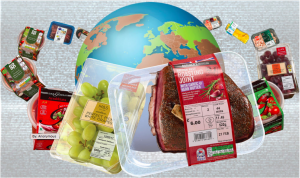Ravenwood is actively helping to reduce the packaging and labelling industry’s carbon footprint – linerless is paving a green path.
Our linerless technology utilises paper and card which travels direct from mill to the printer. No expensive conversion is needed when considering it’s backing paper counterparts. Siliconised liner paper is high in energy as well as cost. This means less transport is required making fewer journeys. And that’s not just in the UK, but on a global scale.
Release liner is a waste product specific to this sector. Eliminating the liner and the silicone reduces waste sent to landfill. In 2017, Ravenwood’s Linerless Labelling System eliminated the need for the production of over 2500 metric tonnes of siliconised liner around the world. This also saves on all the energy required to coproduce it but also the cost of transportation to the convertor and the printer.
Pressure is mounting to reduce waste across all industries and sectors and linerless offers an eco-friendly efficient replacement for traditional self-adhesive labels and cardboard sleeves.
Linerless Labels: Less is More
A standard pressure sensitive label consists of a silicone coated release liner, an adhesive and the face stock. Whereas with linerless, due to the absence of the liner, there is no waste and no need for landfill. See some of the key benefits below:
- Our paper and card goes from the mill to the printer meaning less transport, making fewer journeys
- No expensive conversion is needed when comparing linerless to traditional self-adhesive labels.
- No matrix to dispose of for the printer means less transport to cart away the waste
- Any waste edge trimmings are all recyclable
- No waste liner for the packer again means less transport to discard the waste
In addition to the absence of the backing paper and the environmental drivers, linerless labels offer many benefits. Read more on the full advantages here.
Label Liner and Landfill: Contributing to Dangerous Levels of CO2 and Methane
An estimated 180,000 tonnes of label waste is sent by printers into UK landfill sites each year. The reason this occurs is because the backing liner of adhesive labels is expensive and difficult to recycle and requires a lot of energy. The label liner is made from various materials that are laden with contaminates before being mixed together – these might typically include silicone, ink, adhesives and paper. The combination of these substrates that are fixed together on the same reel means that recycling isn’t widely available.
A large amount of this could be reduced if the labels are linerless. And as mentioned earlier, in 2017, Ravenwood eliminated the production of over 2,500 tonnes of siliconised liner around the planet.
Food Packaging Landscape: The ‘Convenience Culture’
The UK alone produces more than 170m tonnes of waste every year, much of it food packaging. It’s reported that each person throws away five times their own body weight in waste per year. Items that are thrown away are sent to landfill or incinerated. While food packaging has revolutionised the way we store and consume food, there is now so much of it that landfill facilities can’t cope. And with single-use packaging and our throw-away culture, packaging waste has now become a global threat. Some of it is poisonous, and some of it never degrades. It can take 450 years for some types of plastic bottle to break down; one type, PET, while recyclable, doesn’t biodegrade at all. And yet only a third of plastic packaging is recycled.
War on Waste: Is there a solution?
The words Reduce Reuse Recycle is a phrase that has been around for decades. Recycling is now commonplace, and there are newer initiatives like for example, the plastic bag charge. But is this enough? Clearly not. The only solution is to treat the core of the problem and that is for consumers and businesses to make efforts to eliminate or greatly reduce what they throw away and what ultimately ends up in landfill.
For further information contact marketing on +44(0)1284 749144.

Linerless if fighting the war against waste…
